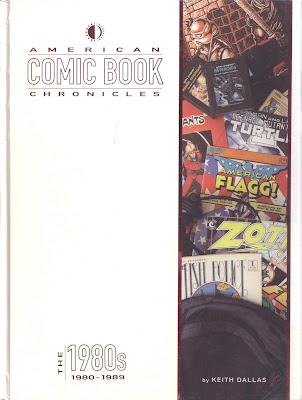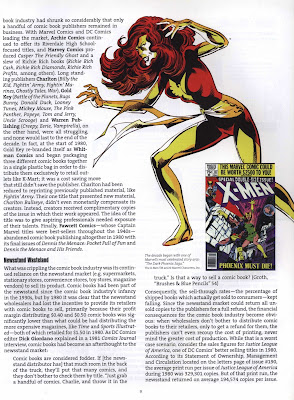The 1980s
by Keith Dallas
TooMorrows Publishing, March 2013
Like the volume covering the 70s, which I reviewed here, this is a great book. It adheres to the standardized format for the series, one marked by copious color illustrations and tiny, dense font.
The opening chapters of 'American Comic Book Chronicles: The 1980s' review the rather dire financial state of the comic book industry in the US in the period from 1979 - 1981. Sales were declining for all publishers, as ever fewer newsstand distributors were interested in selling comic books.
Although Marvel remained the industry's sales leader, the executives of the company's parent corporation, Cadence Industries, were displeased with the low revenue the company was generating from comics. Only by arguing that comics still were a financially viable aspect of magazine publishing, was Marvel president Jim Shooter able to convince the Cadence executives that they should avoid cancelling all but a handful of titles.
As Dallas relates, there was hope that the so-called Direct Market would provide an increasingly viable outlet for comic book sales. But in 1979 there were only 800 comic book stores in the US, and it was not at all clear that the Direct market would grow to the degree necessary to keep comics afloat.
As author Dallas points out, while the publishers struggled to maintain their enterprises, Jim Shooter - having brought a much-needed degree of order to the Marvel editorial offices - began reviving the superhero genre by implementing a reboot of Marvel's X-Men lineup, as well giving greater freedom to new artists and writers, leading to Frank Miller's unique take on Daredevil.
With the gradual growth of dedicated comic book shops throughout the decade, the ranks in independent publishers grew in tandem, and their titles - like Nexus -were able to find shelf space and readership in ways that were simply not feasible in the 70s.
Dallas relates how the 'maturation' of editorial attitudes towards comic book content, and the decisions by both major and minor publishers to no longer ascribe to the Comics Code Authority, brought with it some degree of controversy.
By the middle of the decade, the growth of the Direct Market had begun to compensate for the shrinking newsstand sales market, and comic books had begun to thrive financially. Not only were Marvel and DC benefiting from the Direct Market, but indie titles like the Teenage Mutant Ninja Turtles were major hits.
Dallas devotes coverage to the battles between creators and publishers, Jack Kirby's dispute with Marvel being one of the most visible of these conflicts.
For DC, the decade began with the company still suffering from the aftereffects of the so-called 'DC Implosion' of 1978, which saw many titles cancelled, staff fired or laid off, and sales plummet. But during the 80s, the release of Frank Miller's The Dark Knight helped lead the company to a creative and financial revival. With the release of the blockbuster film Batman in 1989, in September of that year DC actually enjoyed a greater market share than Marvel, a major achievement given that Marvel had dominated the markets since the early 70s.
The final chapters of the book reveal how the financial strength of the comic book industry allowed publishers to release innovative titles that represented genres other than the superhero genre, setting the stage for the enormous expansion of the 90s.
Throughout the book, Dallas's inclusion of callout boxes for topics dealing with the arrival of new approaches to formatting comic books, such as the abolition of thought balloons and third-person narratives, are interesting contributions.
Summing up, like its companion volume for the 70s, 'American Comic Book Chronicles: The 1980s' is well worth getting for anyone with an interest in comics, graphic art, and popular culture.











































































